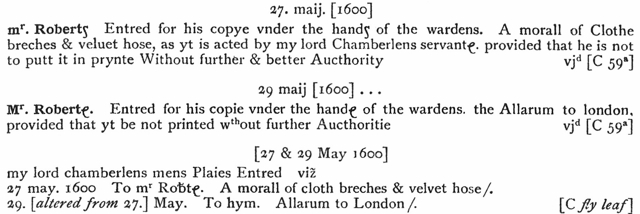Cloth Breeches and Velvet Hose
Historical Records
Stationers' Register
Arber 3.59/161
On 27 May 1600,James Roberts paid 6d. to enter his copy of the following play into the Stationers' Register (Register C, 59a): "A morall of Clothe breches & veluet hose, As yt is Acted by my lord Chamberlens servantes." The clerk added a condition: "PROVIDED that he is not to putt it in prynte Without further and better Aucthority"
On 29 May 1600 the clerk turned to a fly leaf of Register C and began a list headed "my lord chamberlens menns plaies Entred." Following a "viz," he listed two titles: A moral of 'clothe breches and velvet hose' and Allarum to London. Though he left room, no more titles were entered.
On this authority rests the existence of the play, Cloth Breeches and Velvet Hose and its assignment to the repertory of the Chamberlain's men (illustrated below by Greg BEPD 1.15).
Theatrical Provenance
Cloth Breeches and Velvet Hose probably belonged to the Chamberlain's repertory in 1599-1600. The fact that Roberts acquired it in May 1600 suggest that it had already been on stage, and the verb tense of the entry ("is Acted") suggests that its currency was not exhausted. The Chamberlain's Men moved into the Globe playhouse in the late summer or early fall of 1599, so this play would have been among their first batch of acquisitions for their new venue.
Probable Genre(s)
Comedy (Harbage); Estate Satire (Knutson)
Possible Narrative and Dramatic Sources or Analogues
In 1592 Robert Greene published A Quip for an Upstart Courtier, which carries the sub-title "A Quaint Dispute Between Velvet-Breeches and Cloth-Breeches." Google Books, Modern Print ed. Its title-page illustration contrasts the two estates. Image
Knutson summarizes the narrative of Greene's tract as follows (page numbers keyed to GoogleBooks; spelling modernized):
The entire work, Quip for an Upstart Courtier, is a series of dream visions, the last of which provides the story to go with the subtitle “A Quaint Dispute Between Velvet-Breeches and Cloth-Breeches.” In this dream, the narrator sees “an uncouth headless thing” strut arrogantly toward him from a nearby hill (9). The monstrosity—all “legs and hose”—is a pair of Velvet Breeches “whose panes, being made of the chiefest Neapolitan stuff, was drawn out with the best Spanish satin, and marvellous curiously over whipped with gold twist, interseamed with knots of pearl; the nether-stock was of the purest Granado silk” (9). The outfit is completed with rapier and “dagger gilt, point pendant” (9) Before the dreamer can react to this bizarre sight, a second monster marches soberly toward him. This figure is “a plain pair of Cloth-Breeches, without either welte or gard straight to the thigh, of white kersy, without a slop, the nether-stock of the same, sewed to above the knee, and only seamed with a little country blue” (10). It is weaponed with “a good sower bat with a pike in the end” (11). Immediately Velvet Breeches challenges Cloth Breeches for presuming to intrude, and Cloth Breeches counters that he has the prior right due to his lineage among the yeomanry. An argument ensues, in which each puts forward his claim to be the “most ancient and most worthy” (16). The dreamer, turned magistrate, impanels a jury to decide the case. He asks passersby to be jurymen, and he allows the pairs of breeches to disqualify those whose judgment they distrust. Greene used the serial presentation of potential jurors to achieve two ends: he drew distinctions between the moral postures of Cloth Breeches and Velvet Breeches; and he turned the parade of passersby into an estates satire, in which he indicted “the Disorders in all Estates and Trades” (title page).
References to the Play
<List any known or conjectured references to the lost play here.>
Critical Commentary
<Summarise any critical commentary that may have been published by scholars. Please maintain an objective tone!>
For What It's Worth
<Enter any miscellaneous points that may be relevant, but don't fit into the above categories. This is the best place for highly conjectural thoughts.>
Keywords
<Key words that will help categorise this play.>
Works Cited
<List all texts cited throughout the entry, except those staple texts whose full bibliographical details have been provided in the masterlist of Works Cited found on the sidebar menu.>
Site created and maintained by [your name, affiliation; updated DD Month YYYY].
